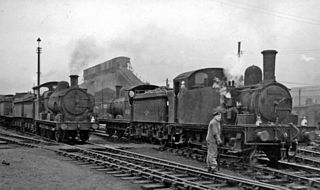Accidents
Railway accidents in 1945 (1945) | |
|---|---|
| Location and date |
|
| Years in rail transport |
|---|
| Timeline of railway history |
This article lists events related to rail transport that occurred in 1945.

The Shay locomotive is a geared steam locomotive that originated and was primarily used in North America. The locomotives were built to the patents of Ephraim Shay, who has been credited with the popularization of the concept of a geared steam locomotive. Although the design of Ephraim Shay's early locomotives differed from later ones, there is a clear line of development that joins all Shays. Shay locomotives were especially suited to logging, mining and industrial operations and could operate successfully on steep or poor quality track.

The War Department was the United Kingdom government department responsible for the supply of equipment to the armed forces of the United Kingdom and the pursuance of military activity. In 1857, it became the War Office. Within the War Office, the name 'War Department' remained in use to describe the military transport services of the War Department Fleet and the War Department Railways.

The United States Army Transportation Corps (USATC) S100 Class is a 0-6-0 steam locomotive that was designed for switching (shunting) duties in Europe and North Africa during World War II. After the war, they were used on railways in Austria, China, Egypt, France, Great Britain, Greece, Iran, Iraq, Israel, Italy, the Netherlands, Palestine, the United States, and Yugoslavia.
The United States Army Transportation Corps S160 Class is a class of 2-8-0 Consolidation steam locomotive, designed for heavy freight work in Europe during World War II. A total of 2,120 were built and they worked on railroads across much of the world, including Africa, Asia, all of Europe and South America.

The United States Army Transportation Corps (USATC) S200 Class is a class of 2-8-2 steam locomotive. They were introduced in 1941 and lent-leased to the United Kingdom for use in the Middle East during World War II.

The United States Army Transportation Corps (USATC) S118 Class is a class of 2-8-2 steam locomotive. Built to either 3 ft, 1,000 mmmetre gauge or 3 ft 6 in gauge, they were used in at least 24 different countries.

The Yosemite Mountain Sugar Pine Railroad (YMSPRR) is a historic 3 ft narrow gauge railway with two operating steam locomotives located near Fish Camp, California, in the Sierra National Forest near the southern entrance to Yosemite National Park. Rudy Stauffer organized the YMSPRR in 1961, utilizing historic railroad track, rolling stock and locomotives to construct a tourist line along the historic route of the Madera Sugar Pine Lumber Company.
Israel Railway Museum is the national railway museum of Israel, located in Haifa. The railway museum is owned by Israel Railways and is located at the Haifa East Railway Station which nowadays no longer serves passengers.

The GER Class R24 was a class of 0-6-0T steams designed by James Holden for the Great Eastern Railway (GER). They passed to the London and North Eastern Railway at the grouping in 1923 and received the LNER classification J67. Some R24s were rebuilt with higher boiler pressure in which form they were similar to the later Class S56. The rebuilt R24s, together with the S56s, were classified J69 by the LNER.

The EMD G16 is a diesel locomotive built by General Motors in the US and under licence by Clyde Engineering in Australia and MACOSA in Spain. It has been used in Australia, Brazil, Egyptian Railways, Hong Kong, Israel Railways, Mexico, Spain, Yugoslav Railways and on the successor Croatian Railways, Slovenian Railways, Serbian Railways, Macedonian Railways, Republika Srpska Railways, Kosovo Railways and Railways of the Federation of Bosnia and Herzegovina.

The Ferrovie dello StatoClass 737 was a class of steam locomotive which consisted of 15 ex-British War Department (WD) 2-8-0 locomotives of the LMS Stanier Class 8F type which were purchased in 1946.

The Queensland Railways AC16 class locomotive was a class of 2-8-2 steam locomotives operated by the Queensland Railways.

The GER Class C72 was a class of thirty 0-6-0T steam locomotives designed by A. J. Hill for the Great Eastern Railway. They passed to the London and North Eastern Railway (LNER) at the 1923 grouping and received the LNER classification J68.

The WAGR U class was a class of 4-6-2 steam locomotives operated by the Western Australian Government Railways (WAGR) between 1946 and the late 1960s. One was rebuilt as a 4-6-4 tank locomotive.

The LNWR 5ft 6in Tank was a class of 160 passenger 2-4-2T locomotives manufactured by the London and North Western Railway in their Crewe Works between 1890 and 1897. The "5ft 6in" in the title referred to the diameter of the driving wheels – although the stated dimension was for the wheel centres – the nominal diameter including the tyres was 5 ft 8+1⁄2 in (1,740 mm).